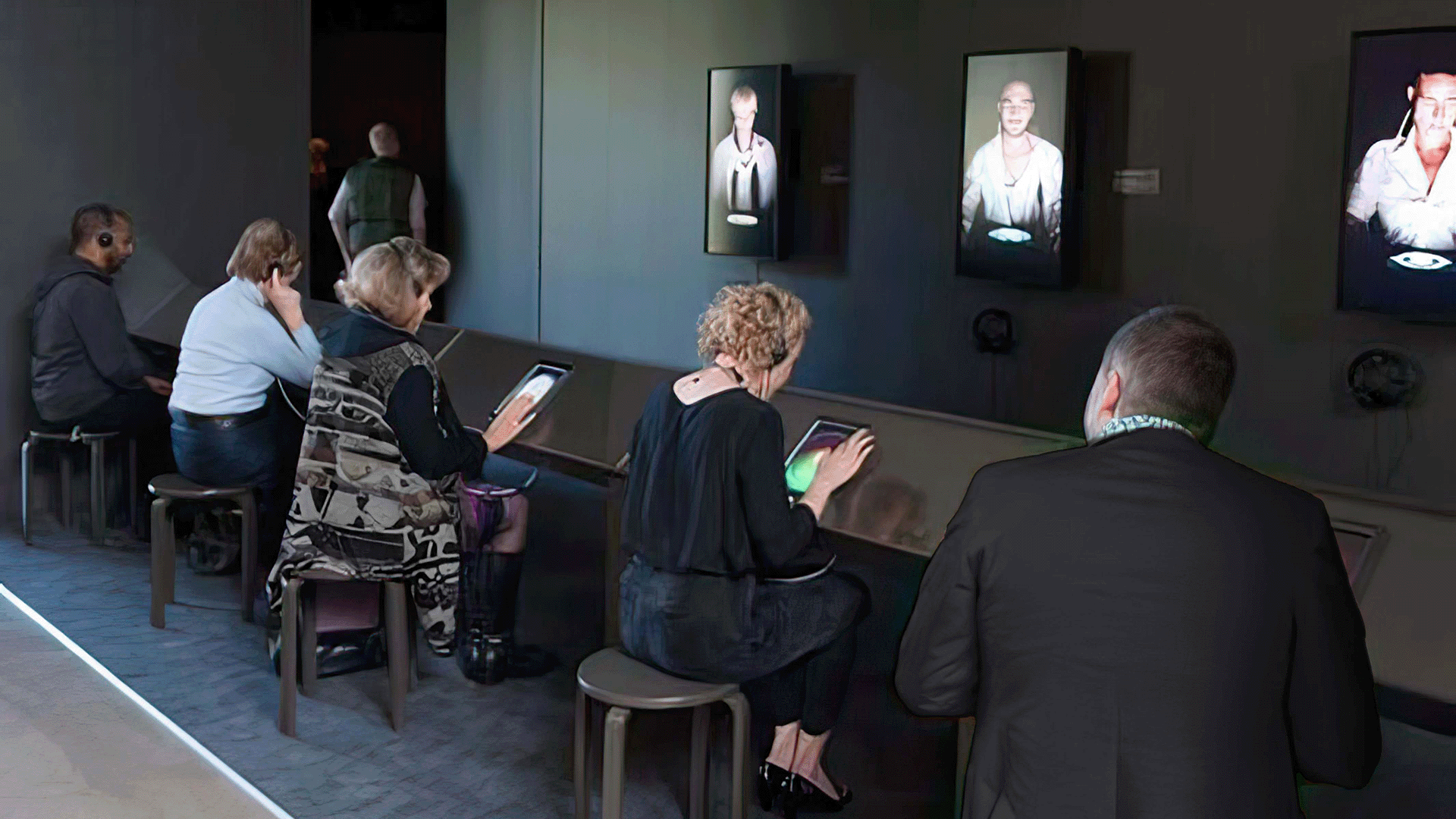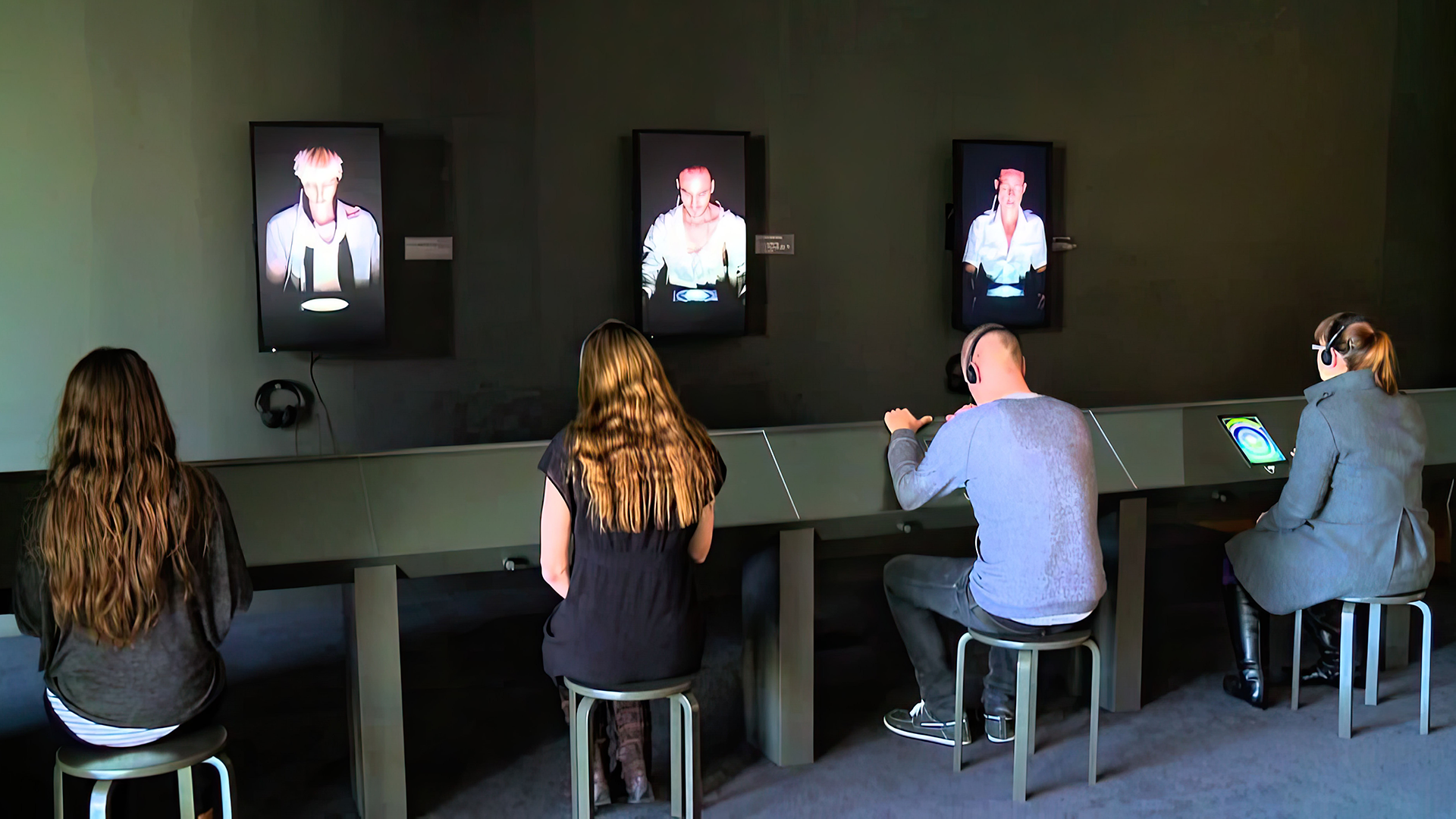Distillery: Waveforming
A prototype tablet-based interactive artwork controlled by changes in heart rate.
Winner of the 2012, Queensland Art Gallery, Gallery of Modern Art, National New Media Art Award.
For this exhibition developed for the Queensland Art Gallery, the iPad works were accompanied by three verrtical format video portraits in which participants recalling the various thoughts, emotions and sensations that emerged during the course of their interaction with the work.
In a medical context, Khut’s iPad app is being developed as a tool to help children to regulate feelings of anxiety and distress associated with, painful clinical procedures.
Reconfigured for interactions in gallery context, this work demonstrates the unique, even wondrous, spaces opened up between mind, body and computer — reminding the audience of their own life force, and what is revealed when we direct our attention quietly inwards towards the most basic elements of being.
Distillery: Waveforming is a prototype iPad app that responds to changes in heart rate and breathing patterns, developed as part of George Khut’s residency at the Children’s Hospital at Westmead in 2011 – developed in collaborationm with Dr Angie Morrow at the Children’s Hospital at Westmead, Kids Rehab.
Comprised of a series of iPad stations, embedded in a long wooden bench, participants interact with the work by attaching a oulse sensor to tgheir findger. tip or ear lobe, and listen to the work with headphones.
The work invites audiences to explore connections between mental, emotional and physiological phenomena, using a combination of slow breathing and quiet attention to produce resonant, wave-like oscillations in heart rate (0.1Hz).
These changes in heart rate drive the appearance of the iPad based artwork: layers of luminous, continually morphing geometric form, and resonant drone and chime-like textures that rise and fall in reponses to changes in heart rate and breathing patterns.
Enigmatic interaction
Catalogue essay by Peter McKay, Curator, Queensland Art Gallery, Gallery of Modern Art
The sound of a heartbeat can draw us into the present with a rare strength and swiftness. In placing one ear on another’s chest, we get and immediate and arresting sense of the rudimentary elements of their being. The intimacy of the moment is heightened with every pulse, and this rhythmic marker of time passing can be a sobering evocation of mortality. Such a powerful experience pierces the stream of distractions that crowd our attention and relocates us in the material of life. George Poonkhin Khut’s practice is attuned to this understanding; to this end, he has often employed the audience as part of the medium in order to provide them a particular awareness of the world that exists uniquely within.
Distillery: Waveforming is the evolution of a project initially developed as an experimental relaxation training system for managing the pain and anxiety experienced by children undergoing recurrent painful clinical procedures. The hardware of the work is comprised of a clip-on heart monitor and an iPad that displays layers of geometric-styled graphics with an accompanying soundscape. The iPad ‘app’ is currently driven by an additional computer that analyses and translates the user’s heart rate pattern, but future upgrades will see this operation run within the iPad. The system’s configuration enables the ‘sitter’ to interact with a live, abstract visualisation of their own heart rhythm. Layers of luminous, continually morphing geometric form, create a circular loop of information between body, mind and machine known as biofeedback.
Khut’s invitation to the audience is to explore the connections between mental, emotional and physiological phenomena they experience. By using a combination of measured breathing and quiet attention, users can produce resonant, wave-like oscillations in their heart rate pattern that coincide with a breathing rate of around ten seconds per breath-cycle (six breath per minute). These pronounced, wave like changes heart rate, occur spontaneously in many forms of meditation and devotional practice. Through this arrangement of technology, otherwise hidden or hard to perceive body-mind interactions are made appreciable, and plastic through the enhanced awareness they provide.
Initially developed for use in a medical context at the Children’s Hospital at Westmead Kids Rehab unit, New South Wales, the therapeutic and pedagogical intent of Khut’s work is clear. Transferred to a gallery space, the engaging nature of the work presents the opportunity for a unique aesthetic experience of one’s own life force and immediate interactions between attention, emotion and physiology.
Khut’s desire to focus our attention inwards towards a poetics of attention and being present to our experience of ourselves, relates to the writings of contemporary North American philosopher Richard Shusterman and his concept of ‘somaesthetics’. Somaesthetics is conceived as a sub-discipline of aesthetics in which Shusterman has attempted to broaden our aesthetic experiences from its definition as a sensory experience of the outside world to include the ‘beautiful experience of one’s own body from within — the endorphin-enhanced glow of high-level breathing, the tingling thrill of feeling into new parts of one’s spine’.[1]
Shusterman believes that the philosophical project of aesthetics — in essence, the distillation of art and the experience of beauty into theoretical terms — has privileged intellectual values and neglected, or actively belittled, the worth of somatic knowledge, that is, the learning and accomplishments of the body. Citing principles held by Socrates, Shusterman argues that Western philosophy’s roots have a strong basis in the pursuit of a sound mind and body, and that neglect of our bodies will often translate to faults of mental and physical health. [2]
Khut’s understanding of the historical circumstances we find ourselves in, as articulated by Shusterman, gives rise to his innovative challenge to the narrowing of ‘art’. While some would argue that expectations of what a body should be are often used as a means of repressing, controlling and exploiting through oppressive normative models, Shusterman retorts:
Potent as such indictments may be, they all depend on construing somaesthetics as a theory that reduces the body to an external object — a mechanical instrument of atomized parts, measurable surfaces and standardized norms of beauty. They ignore the body’s subject-role as the living locus of beautiful, personal experience. But somaesthetics, in its experiential dimension, clearly refuses to exteriorize the body as an alienated thing distinct from the active spirit of human experience. Nor does it necessarily impose a fixed set of standardized norms of external measurement (e.g., optimal pulse) to assess good somaesthetic experience. [3]
Through the accompanying suite of video portraits of participants using the system, we hear an overlayed commentary as the sitter recalls the various thoughts, sensations and strategies that emerged during the course of their interaction. Recognising the subjective experiences of others we can come to better comprehend the greater dimensions we all share. Khut’s work reveals the diversity of our speculations brought forth by the enigmatic interaction between mind and body, and the beauty of becoming attuned to their connection.
End Notes
Richard Shusterman, ‘Somaesthetics: A disciplinary proposal’, The Journal of Aesthetics and Art Criticism, vol.57, no.3 (Summer 1999), pp.299–313.
Shusterman, p.302.
Shusterman, p.306.
Production Credits
George Khut: Interaction concept, visualization programming and interactive sound design (Max)
Angelo Fraietta (SmartController) and Tuan M. Vu: Signal analysis software
Jason McDermott: iOS visualisation software by adapted from original code by Greg Turner.
Julia Charles: Video Portrait Lighting and photography
Troy Brennan: Portrait styling
Acknowledgements
This project has been upported by the Australian Network for Art and Technology and the Children’s Hospital at Westmead, Kids Rehab in association with the Australian Government through the Australia Council for the Arts, its arts funding and advisory body.
Special thanks to Dr Angie Morrow (Kids Rehab), Frank Maguire (electronics and design), UNSW Creative Practices Research Lab (iO Myers Studio), and Kevin Jackson.


